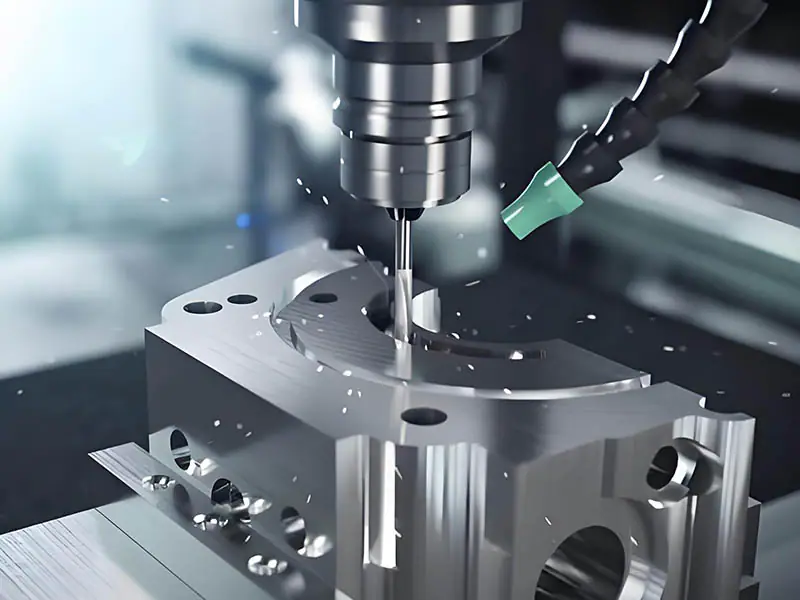In manufacturing industries such as machinery equipment production and casting, we often encounter the term “CNC machining.” So, is CNC machining important in manufacturing? Yes, it is crucial. CNC (Computer Numerical Control) is a manufacturing technology that automates machine tools using pre-programmed software and code, enabling precise control over operations like cutting, shaping, drilling, or milling to produce parts.
This article will delve into how CNC machines operate and explain why they are so indispensable in manufacturing components for automotive parts, general machinery, and beyond.

What is CNC Machining?
Computer Numerical Control Machine (CNC) is a processing tool that converts pre-designed graphics or 3D graphics of the parts to be processed into complex CNC mechanical movements using 3D programming software, including lathes, grinders, milling machines, drilling machines, etc. CNC machines can process materials or die-cast blanks by using the cutting paths generated by the programming software.
Core Principle: CAD models → CAM-generated G-code → Machine execution.
The History of CNC Machining
The history of CNC processing began in the late 1940s, when John Parsons proposed the concept and collaborated with MIT to develop it. Initially, it was designed to solve the problems of manufacturing complex aviation components. The machine tools were controlled using punched paper tapes (referred to as NC). With the development of computer technology, in the late 1960s to the 1970s, small computers were integrated into the control unit, giving birth to the true CNC (Computer Numerical Control), which enabled program storage, editing, and more complex functions. Subsequently, the maturity of microprocessors, CAD/CAM software, the improvement of multi-axis processing capabilities, and the promotion of networked intelligence (Industry 4.0) transformed CNC from an expensive and complex specialized equipment into the core cornerstone of modern manufacturing for achieving high precision, high efficiency, and high flexibility automated production, completely changing the way of product design and manufacturing.
How CNC Machining Works?
CNC machining is a precise and automated manufacturing process used to create complex parts from a wide range of materials. It combines design, programming, and machine operation to produce components with high accuracy and repeatability. The process can be broken down into five key steps, each playing a crucial role in transforming a concept into a finished product. From the initial design to the final quality inspection, every stage ensures that the part meets the required specifications and performs as intended. Here’s a closer look at how CNC machining works, step by step.
Step 1: Design Phase – Creating the CAD Model
The first step in CNC machining is the design phase, where a detailed 3D model of the part is created using Computer-Aided Design (CAD) software. Engineers or designers define the exact dimensions, shape, and features of the part based on its functional requirements. This digital model serves as the foundation for all subsequent steps in the CNC machining process.
Step 2: Conversion Phase – Translating CAD into Machine Code
Once the CAD model is complete, it needs to be converted into instructions that the CNC machine can understand. This is done using Computer-Aided Manufacturing (CAM) software, which translates the CAD file into G-code or M-code—programming languages that tell the machine how to move, which tools to use, at what speed, and along what path to cut the material.
Step 3: Setup Phase – Preparing the CNC Machine
Before machining begins, the CNC machine must be properly set up. This includes selecting and installing the appropriate cutting tools, securing the raw material onto the machine bed, and ensuring all safety measures are in place. The machine is also calibrated to ensure accuracy during the machining process.
Step 4: Machining Phase – Executing the Program
With everything set up, the CNC machine runs the program created in the previous step. The machine automatically controls the movement of the cutting tools according to the G-code instructions, removing material from the workpiece to create the desired shape. This phase is highly precise and can involve various operations such as milling, turning, drilling, or grinding.
Step 5: Inspection Phase – Ensuring Quality Standards
After the machining process is complete, the final part undergoes inspection to ensure it meets the required specifications and quality standards. Various measuring tools and techniques—such as calipers, coordinate measuring machines (CMM), or visual inspections—are used to check dimensional accuracy and surface finish. Any deviations may require adjustments to the process or re-machining.
What Will the Future CNC Machining Process Look Like?
The future of CNC machining is poised to be shaped by several emerging trends and technologies, promising enhanced efficiency, precision, and flexibility. Here are some key aspects that might define the CNC machining process in the future:
- Increased Automation and Integration: Future CNC machines will likely feature even higher levels of automation, with increased integration into smart factories. This includes automated tool changing, material handling, and even autonomous setup and teardown processes, reducing the need for human intervention.
- Advanced Materials and Processes: As new materials are developed, CNC machining processes will adapt to work with these materials efficiently. This could include advancements in cutting techniques, coolants, and tools designed specifically for challenging materials like composites or superalloys.
- Improved Software and Programming: The development of more intuitive CAD/CAM software will make programming CNC machines easier and faster. Artificial intelligence (AI) and machine learning algorithms may predict optimal toolpaths, anticipate maintenance needs, and automatically adjust parameters for better performance and reduced waste.
- Enhanced Precision and Speed: Innovations in spindle technology, motion control systems, and feedback mechanisms will allow for even greater precision and speed. This means tighter tolerances and faster production times, meeting the growing demand for high-quality parts.
- Sustainability and Energy Efficiency: There will be a stronger focus on making CNC machining more sustainable through energy-efficient operations and the use of recyclable materials. Technologies that minimize waste and reduce energy consumption will become increasingly important.
- Customization and Flexibility: With the rise of Industry 4.0, CNC machines will be capable of producing highly customized products with shorter lead times. The ability to quickly switch between different production runs without extensive retooling will enable manufacturers to offer more personalized solutions to their customers.
Overall, the future of CNC machining looks towards a blend of advanced technologies and practices aimed at achieving superior productivity, sustainability, and customization capabilities.
CNC vs. 3D Printing: When to Choose Which?
Certainly! Here’s a simplified comparison chart to help determine when to choose CNC machining versus 3D printing based on various factors:
| Criteria/Consideration | CNC Machining | 3D Printing |
|---|---|---|
| Suitable for Production Type | Ideal for medium to large-scale production runs. | Better suited for small batches or one-off custom pieces. |
| Material Options | Wide range of materials including metals, wood, plastics, etc. | Limited material options, mostly various plastics and some metal powders. |
| Cost Efficiency | High initial setup cost but lower per-unit cost as volume increases. | Lower initial equipment investment, but can be costly for complex parts over time. |
| Design Complexity | More challenging for manufacturing parts with complex internal structures. | Capable of easily producing parts with intricate geometries and internal structures. |
| Precision and Surface Finish | Offers high precision and excellent surface finish. | Good precision but often requires post-processing for improved surface finish. |
| Production Speed | Faster for producing parts with simple to moderate complexity. | Slower, especially for larger or more detailed prints. |
| Waste Generation | Generates more waste due to subtractive process. | Less waste due to additive manufacturing process. |
| Tooling Requirement | Requires specific tooling which may need adjustments or replacements. | No traditional tooling required, reducing setup time. |
This table provides a snapshot to assist in deciding between CNC machining and 3D printing. The choice depends on the project requirements, budget considerations, material preferences, design complexity, and desired production scale.
CNC FAQ
Q: What’s the minimum CNC order quantity?
*A: Prototypes from 1 unit; bulk discounts at 500+.*
Q: How to reduce aluminum machining burrs?
A: Use sharp carbide tools, high RPM, and climb milling.
Q: What certifications do CNC operators need?
A: NIMS credentials + OSHA safety training.


